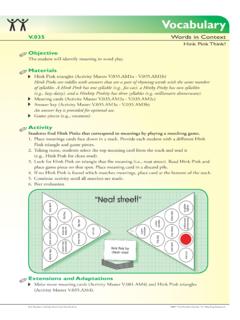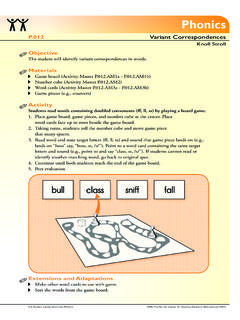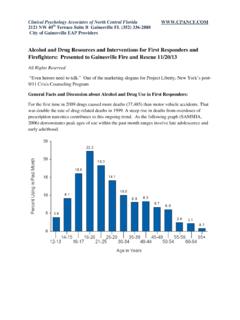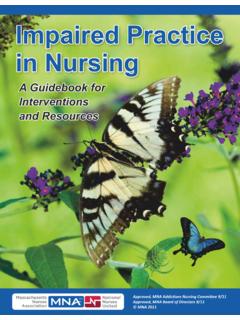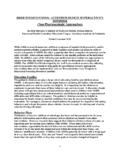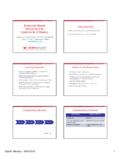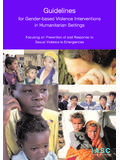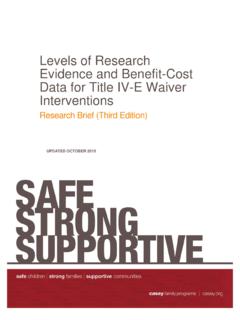Transcription of TEACHING ALL STUDENTS TO READ IN ELEMENTARY SCHOOL
1 TEACHING ALL STUDENTS TO read . IN ELEMENTARY SCHOOL . A Guide for Principals TEACHING ALL STUDENTS TO read . IN ELEMENTARY SCHOOL . A Guide for Principals Joseph Torgesen, Debra Houston, Lila Rissman, Marcia Kosanovich Florida Center for Reading Research Florida State University 2007. This publication was created for the Center on Instruction by the Florida Center for Reading Research at Florida State University. The Center on Instruction is operated by RMC. Research Corporation in partnership with the Florida Center for Reading Research at Florida State University; Horizon Research, Inc.; RG Research Group; the Texas Institute for Measurement, Evaluation, and Statistics at the University of Houston; and the Vaughn Gross Center for Reading and Language Arts at the University of Texas at Austin. The contents of this document were developed under cooperative agreement S283B050034 with the Department of Education.
2 However, these contents do not necessarily represent the policy of the Department of Education, and you should not assume endorsement by the Federal Government. Editorial, design, and production services provided by RMC. Research Corporation. Preferred citation: Torgesen, J., Houston D., Rissman, L., & Kosanovich, K. (2007). TEACHING all STUDENTS to read in ELEMENTARY SCHOOL : A guide for principals. Portsmouth, NH: RMC Research Corporation, Center on Instruction. To download a copy of this document, visit CONTENTS. 1 INTRODUCTION. 3 CRITICAL ELEMENTS OF AN EFFECTIVE READING PROGRAM. IN ELEMENTARY SCHOOL . 11 CRITICAL TASKS FOR PRINCIPALS AS LITERACY LEADERS. 25 SPECIAL CONSIDERATIONS FOR READING INSTRUCTION. AFTER THIRD GRADE. 29 CONCLUDING COMMENTS. 31 RECOMMENDATIONS FOR ADDITIONAL READING. INTRODUCTION. If your goal is to improve the overall quality of reading instruction in your SCHOOL , this guide can help you identify the most critical changes that must be made.
3 It describes the types of instruction and leadership activities necessary to help all children become proficient readers in ELEMENTARY SCHOOL . It does not contain all the information needed, but refers you to additional readings in specific areas to enrich your knowledge. Think of it as a quick start guide for a SCHOOL -level instructional leader. It can point you in the right direction, but it can only provide a taste of the knowledge needed to be a successful literacy leader in your SCHOOL . We encourage you to become familiar with the ideas in the guide, and then embark on a program of systematic study to fully prepare for this challenging and rewarding task. This guide is based on scientific research on reading and reading instruction, as well as on studies of successful schools and interviews with successful principals. The most important goal of reading instruction in ELEMENTARY SCHOOL is to help STUDENTS acquire the skills and knowledge they need to read grade-level text fluently and with good comprehension.
4 Reading comprehension is a very complex skill. Its most essential elements involve: skill in reading text accurately and fluently;. sufficient background knowledge and vocabulary to make sense of the content;. skill in using reading strategies that improve understanding or repair it when it breaks down;. ability to think and reason about the information and concepts in the text;. and motivation to understand and learn from text. In other words, reading proficiency at the end of ELEMENTARY SCHOOL requires that STUDENTS be able to identify the words on the page accurately and fluently;. that they have enough knowledge and thinking ability to understand the words, sentences, and paragraphs; and that they be motivated and engaged enough to use their knowledge and thinking ability to understand and learn from the text. We want to emphasize that motivation to understand and learn from text is a critical component of reading comprehension.
5 It takes real effort to understand 1. the many textbooks and other forms of complex written materials STUDENTS begin to encounter as they move through ELEMENTARY SCHOOL and into middle and high SCHOOL . Unless STUDENTS are appropriately engaged, they often do not fully apply the skills they have, nor will they be motivated to acquire additional skills and knowledge. 2. CRITICAL ELEMENTS OF AN EFFECTIVE READING. PROGRAM IN ELEMENTARY SCHOOL . Although the focus of reading instruction changes dramatically from the early to later grades, three program elements are critical at all grade levels: 1. Consistently implemented, high quality initial classroom instruction and follow-up small-group instruction that is well-differentiated according to student needs. Teachers at all grades must be prepared to provide strong initial instruction in critical skills and knowledge to their classroom as a whole. At every grade, specific skills must be taught and specific knowledge acquired to meet grade-level standards in reading.
6 Teachers must be able to support student growth in critical areas through skillful, systematic, and explicit instruction at the whole classroom level;. they must also be able to work effectively with small groups of STUDENTS who have different instructional needs. Small-group instruction is necessary because STUDENTS in most classes vary widely in their instructional needs, and their diverse needs are best met when instruction is at the right level and focused on areas of most critical need. Appropriately differentiated instruction involves even deeper TEACHING skills than whole-classroom instruction, because it requires teachers to diagnose individual needs and make appropriate adjustments to their instructional focus and instructional routines. 2. Use of student performance data to guide instruction and allocate instructional resources. Data on student performance in reading from both formal and informal assessments have two important uses in ELEMENTARY schools.
7 First, data provide valuable information to help teachers adapt instruction for individual STUDENTS . Valid and reliable assessments of reading progress provide key information that allows teachers to target their instruction for individual STUDENTS , and it also allows them to determine when further adjustments need to be made because of a lack of student progress. Second, reliable data on student progress are useful for principals in making important SCHOOL -level decisions about instruction and allocation of resources, such as decisions about: a) scheduling classes, b) assigning STUDENTS to classes, c) planning professional development and support for each grade level as well as 3. individual teachers, and d) allocating resources to support extra instruction for STUDENTS who need it. 3. Resources to provide interventions for struggling readers. Even when teachers are providing excellent initial instruction and effective small-group differentiated instruction, some STUDENTS ' instructional needs will still not be met.
8 In many ELEMENTARY schools, the diversity of talent and preparation for learning to read is so great that some STUDENTS will require four or five times the amount of instruction an average student requires. Some STUDENTS ' needs are simply too great to expect the individual teacher, by herself, to meet them. Research has shown that we must provide reading instruction for diverse groups of STUDENTS along a continuum of intensity: some STUDENTS can maintain adequate progress through whole-class instruction; others need extra assistance through differentiated support by the classroom teacher; and still others may require substantial additional instruction from reading intervention specialists. The principal must identify a variety of additional instructional resources to meet the needs of these STUDENTS . In a later section of this guide, we discuss leadership activities required to implement each of these elements in a SCHOOL -level literacy plan.
9 We introduce the elements here because they are the core areas of excellence found in almost all schools that have achieved success in TEACHING reading to diverse student populations. Successful principals employ a range of leadership styles and vary in their solutions to many specific problems, but the most successful schools consistently develop strong solutions in each of the three areas described above. Without effective initial classroom instruction and strongly differentiated instruction by classroom teachers, the need for intervention specialists may simply overwhelm SCHOOL resources because too many STUDENTS will not make expected yearly progress. Unless the SCHOOL has a strong assessment plan and uses student data effectively in making decisions, instructional opportunities will be lost, and resources may not be allocated properly. Finally, unless strong, timely interventions are available to STUDENTS who need them, significant numbers of STUDENTS will continue to leave ELEMENTARY SCHOOL unprepared for the literacy demands of middle and high SCHOOL .
10 4. The Changing Focus of Reading Instruction from Kindergarten to Late ELEMENTARY SCHOOL Dr. Jeanne Chall, a leading reading researcher and educator for many years at Harvard University, coined a phrase that is widely quoted, but often misunderstood. She pointed out that, in grades K-2, STUDENTS are learning to read , while in grades 3 and above, they are reading to learn. While reading does become an increasingly important tool for helping STUDENTS expand their knowledge after grade three, learning to read hardly comes to an abrupt halt at the end of second or third grade. Our current understanding of reading growth indicates that STUDENTS must continue to learn many new things, and acquire many additional skills, in order to maintain reading proficiency as they progress from early to late ELEMENTARY SCHOOL and beyond. It is a serious mistake to think that we can stop TEACHING reading after third grade many STUDENTS continue to need explicit and systematic instruction in increasingly complex skills in order to move to higher levels of reading proficiency.
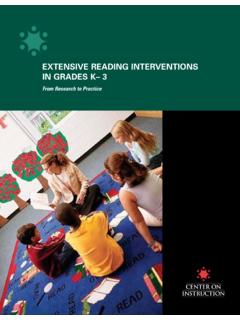

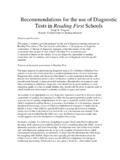
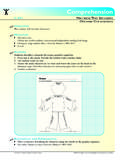
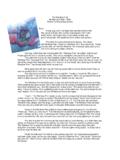
![Assessments for Secondary Students.ppt [Read-Only]](/cache/preview/9/8/f/2/d/f/a/0/thumb-98f2dfa0f0af200f0fe379df10741ab3.jpg)
